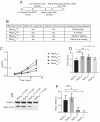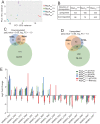Domains within RbpA Serve Specific Functional Roles That Regulate the Expression of Distinct Mycobacterial Gene Subsets
- PMID: 29686140
- PMCID: PMC5996690
- DOI: 10.1128/JB.00690-17
Domains within RbpA Serve Specific Functional Roles That Regulate the Expression of Distinct Mycobacterial Gene Subsets
Abstract
The RNA polymerase (RNAP) binding protein A (RbpA) contributes to the formation of stable RNAP-promoter open complexes (RPo) and is essential for viability in mycobacteria. Four domains have been identified in the RbpA protein, i.e., an N-terminal tail (NTT) that interacts with RNAP β' and σ subunits, a core domain (CD) that contacts the RNAP β' subunit, a basic linker (BL) that binds DNA, and a σ-interaction domain (SID) that binds group I and group II σ factors. Limited in vivo studies have been performed in mycobacteria, however, and how individual structural domains of RbpA contribute to RbpA function and mycobacterial gene expression remains mostly unknown. We investigated the roles of the RbpA structural domains in mycobacteria using a panel of rbpA mutants that target individual RbpA domains. The function of each RbpA domain was required for Mycobacterium tuberculosis viability and optimal growth in Mycobacterium smegmatis We determined that the RbpA SID is both necessary and sufficient for RbpA interaction with the RNAP, indicating that the primary functions of the NTT and CD are not solely association with the RNAP. We show that the RbpA BL and SID are required for RPo stabilization in vitro, while the NTT and CD antagonize this activity. Finally, RNA-sequencing analyses suggest that the NTT and CD broadly activate gene expression, whereas the BL and SID activate or repress gene expression in a gene-dependent manner for a subset of mycobacterial genes. Our findings highlight specific outcomes for the activities of the individual functional domains in RbpA.IMPORTANCEMycobacterium tuberculosis is the causative agent of tuberculosis and continues to be the most lethal infectious disease worldwide. Improved molecular understanding of the essential proteins involved in M. tuberculosis transcription, such as RbpA, could provide targets for much needed future therapeutic agents aimed at combatting this pathogen. In this study, we expand our understanding of RbpA by identifying the RbpA structural domains responsible for the interaction of RbpA with the RNAP and the effects of RbpA on transcription initiation and gene expression. These experiments expand our knowledge of RbpA while also broadening our understanding of bacterial transcription in general.
Keywords: Mycobacterium; RNA polymerases; RbpA; eubacteria; transcription; transcriptional regulation.
Copyright © 2018 American Society for Microbiology.
Figures




Similar articles
-
Molecular dissection of RbpA-mediated regulation of fidaxomicin sensitivity in mycobacteria.J Biol Chem. 2022 Apr;298(4):101752. doi: 10.1016/j.jbc.2022.101752. Epub 2022 Feb 19. J Biol Chem. 2022. PMID: 35189142 Free PMC article.
-
RbpA relaxes promoter selectivity of M. tuberculosis RNA polymerase.Nucleic Acids Res. 2018 Nov 2;46(19):10106-10118. doi: 10.1093/nar/gky714. Nucleic Acids Res. 2018. PMID: 30102406 Free PMC article.
-
Mycobacterium RbpA cooperates with the stress-response σB subunit of RNA polymerase in promoter DNA unwinding.Nucleic Acids Res. 2014;42(16):10399-408. doi: 10.1093/nar/gku742. Epub 2014 Aug 13. Nucleic Acids Res. 2014. PMID: 25122744 Free PMC article.
-
Sigma and RNA polymerase: an on-again, off-again relationship?Mol Cell. 2005 Nov 11;20(3):335-45. doi: 10.1016/j.molcel.2005.10.015. Mol Cell. 2005. PMID: 16285916 Review.
-
The σ Subunit-Remodeling Factors: An Emerging Paradigms of Transcription Regulation.Front Microbiol. 2020 Jul 29;11:1798. doi: 10.3389/fmicb.2020.01798. eCollection 2020. Front Microbiol. 2020. PMID: 32849409 Free PMC article. Review.
Cited by
-
Genomic Characteristics Revealed Plasmid-Mediated Pathogenicity and Ubiquitous Rifamycin Resistance of Rhodococcus equi.Front Cell Infect Microbiol. 2022 Feb 16;12:807610. doi: 10.3389/fcimb.2022.807610. eCollection 2022. Front Cell Infect Microbiol. 2022. PMID: 35252029 Free PMC article.
-
High-throughput, fluorescent-aptamer-based measurements of steady-state transcription rates for the Mycobacterium tuberculosis RNA polymerase.Nucleic Acids Res. 2023 Oct 27;51(19):e99. doi: 10.1093/nar/gkad761. Nucleic Acids Res. 2023. PMID: 37739412 Free PMC article.
-
Regulation of Steady State Ribosomal Transcription in Mycobacterium tuberculosis: Intersection of Sigma Subunits, Superhelicity, and Transcription Factors.bioRxiv [Preprint]. 2025 Feb 27:2025.02.24.639987. doi: 10.1101/2025.02.24.639987. bioRxiv. 2025. Update in: J Biol Chem. 2025 Jun 12;301(8):110369. doi: 10.1016/j.jbc.2025.110369. PMID: 40060575 Free PMC article. Updated. Preprint.
-
The Context-Dependent Influence of Promoter Sequence Motifs on Transcription Initiation Kinetics and Regulation.J Bacteriol. 2021 Mar 23;203(8):e00512-20. doi: 10.1128/JB.00512-20. Print 2021 Mar 23. J Bacteriol. 2021. PMID: 33139481 Free PMC article. Review.
-
Transcription initiation in mycobacteria: a biophysical perspective.Transcription. 2020 Apr;11(2):53-65. doi: 10.1080/21541264.2019.1707612. Epub 2019 Dec 27. Transcription. 2020. PMID: 31880185 Free PMC article. Review.
References
-
- World Health Organization. 2016. Global tuberculosis report 2016. World Health Organization, Geneva, Switzerland: http://apps.who.int/iris/bitstream/handle/10665/250441/9789241565394-eng....
Publication types
MeSH terms
Substances
Grants and funding
LinkOut - more resources
Full Text Sources
Other Literature Sources
Molecular Biology Databases
Research Materials

